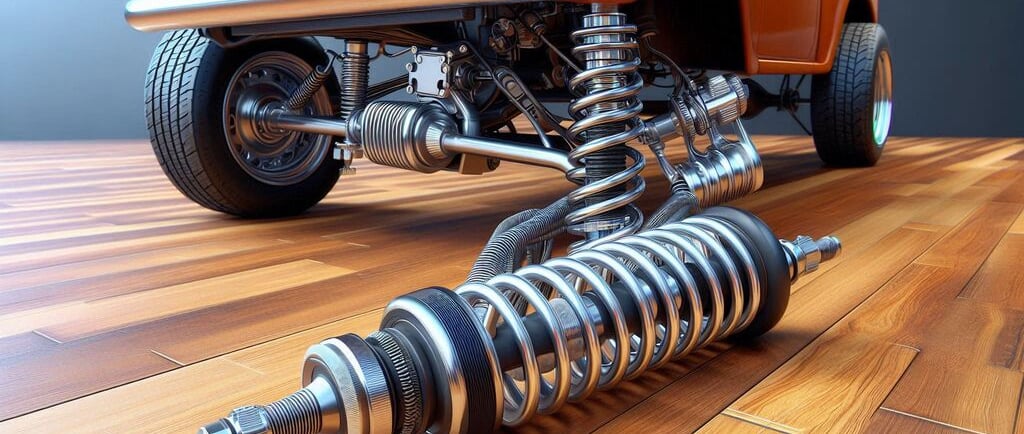Sway Bars/Stabilizer Bars Reduce body roll during turns.
If you’ve ever wondered why your car feels stable when you take a sharp turn or why it doesn’t tip as much as you might expect, sway bars (also known as stabilizer bars) are largely responsible.
CHASSIS AND FRAME PARTS
11/13/20244 min read


Understanding Sway Bars: The Key to Smoother, Safer Turns
If you’ve ever wondered why your car feels stable when you take a sharp turn or why it doesn’t tip as much as you might expect, sway bars (also known as stabilizer bars) are largely responsible. These vital suspension components help reduce body roll during turns, adding stability to your driving experience. Let’s dive into how sway bars work, why they’re essential, and what to know if you’re considering upgrading or replacing them.
What Are Sway Bars?
The Basics of Sway Bars
A sway bar, sometimes called a stabilizer bar or anti-roll bar, is a key component of your vehicle’s suspension system. Essentially, it’s a metal bar that connects the left and right wheels of a car, helping to balance the vehicle during turns. It acts as a bridge between the wheels, counteracting the body’s natural tendency to lean or roll, especially during fast or sharp turns.
Why Sway Bars Matter
When you make a turn, centrifugal force causes the car’s body to lean outward, creating body roll. Sway bars help minimize this roll, keeping the car balanced and reducing the risk of losing control. By doing so, they not only enhance handling but also improve overall safety. For sports cars, trucks, and SUVs, which may be more prone to rollovers due to higher centers of gravity, sway bars are especially important.
How Do Sway Bars Work?
The Mechanics Behind Sway Bars
Sway bars are designed to transfer force from one side of the vehicle’s suspension to the other. When the vehicle turns, the sway bar twists slightly, helping to resist the body’s natural inclination to roll. This action keeps the car flat, helping it stay steady on the road. Here’s a breakdown of how they work:
Connection to Suspension: The sway bar connects both sides of the suspension, usually through end links and bushings.
Force Transfer: As the vehicle leans to one side, the sway bar twists, transferring some of that force to the opposite side, creating balance.
Improved Handling: By resisting roll, sway bars make the vehicle more responsive, giving you more confidence while driving, especially on winding roads.
Types of Sway Bars
Not all sway bars are the same. Here are the common types found in vehicles:
Front Sway Bars: Typically more robust, as they handle the majority of the body’s roll during turns.
Rear Sway Bars: Often found on performance vehicles to aid cornering stability.
Adjustable Sway Bars: These allow for tuning to achieve a specific handling balance, which is popular among performance enthusiasts.
Benefits of Sway Bars in Everyday Driving
Enhanced Stability and Safety
One of the main advantages of sway bars is that they make everyday driving safer. By reducing body roll, they ensure that your car stays balanced, even on sharp turns. This added stability also decreases the risk of rollovers in taller vehicles like SUVs and trucks, making sway bars an essential feature for family vehicles as well.
Improved Cornering and Handling
For those who enjoy a spirited drive, sway bars provide better cornering ability. They help keep your tires planted on the road, allowing you to take corners at faster speeds without sacrificing control. This makes sway bars popular among car enthusiasts and drivers who prioritize precision handling.
Signs Your Sway Bar Needs Maintenance or Replacement
Over time, your sway bar can experience wear and tear, especially in the bushings and end links. Here are some signs that your sway bar may need attention:
Clunking or Squeaking Sounds
If you hear a clunking noise when you turn or go over bumps, it could be due to worn sway bar bushings or links. Squeaking sounds can also indicate a need for lubrication or replacement.Increased Body Roll
If your vehicle feels more unstable during turns, it might mean the sway bar or its components have worn out, reducing its effectiveness in counteracting roll.Poor Handling
If you notice decreased handling performance, such as reduced cornering stability, it may be time to inspect your sway bar.
Can You Upgrade Your Sway Bars?
Choosing the Right Sway Bar for Your Vehicle
Many drivers, particularly those with performance vehicles, opt to upgrade their sway bars. Here are some reasons why you might consider it:
Better Handling for High-Performance Driving: Upgrading to a thicker or adjustable sway bar can provide sharper, more responsive handling.
Enhanced Off-Road Stability: For off-road vehicles, sway bar upgrades improve stability on rugged terrain by reducing unwanted body movement.
If you’re considering an upgrade, consult a professional mechanic to ensure the sway bar is compatible with your vehicle and fits your driving needs.
DIY or Professional Installation?
While installing a sway bar can be a DIY project for those with experience, it’s generally best left to a professional mechanic, especially for adjustable or high-performance sway bars. Incorrect installation can lead to handling issues and safety concerns.
Conclusion: Keep Rolling Smoothly with a Sway Bar
Sway bars are one of those hidden components that many drivers rarely think about, but they play a huge role in ensuring safety and comfort on the road. From reducing body roll to improving cornering, they’re essential for smooth, stable handling. Whether you’re driving a high-performance sports car or a family SUV, understanding and maintaining your sway bar is crucial for safe driving.
If your vehicle’s handling feels off or you hear unusual noises during turns, it might be time to check your sway bar. For those looking to enhance their car’s handling, upgrading your sway bar can be a game-changer.



